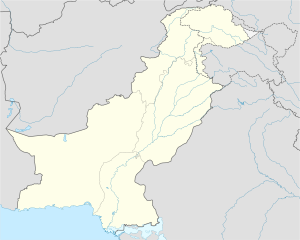Campbellpur
|
Attock اٹک Campbellpur |
|
|---|---|
| City | |
| Coordinates: Coordinates: | |
| Country | Pakistan |
| Province | Punjab |
| Established | 1904 |
| Incorporated | 1978 |
| Area | |
| • Total | 6,857 km2 (2,648 sq mi) |
| Population (1998) | |
| • Total | 69,588 |
| Time zone | PKT (UTC5) |
| Postal code span | 43600 |
| Area code(s) | 057 |
| Website | www.attockonians.com] |
Attock (Punjabi, Urdu: اٹک) formerly Campbellpur, is a city located in the northern border of the Punjab province of Pakistan and the headquarters of . In the 1901 census, Attock was reported to have had a population of 2866 people, a figure which has grown dramatically during the 20th century with 69,588 reported in the 1998 census and contemporary estimates approaching 100,000.
It is located on the bank of the Indus, 80 km (50 mi) from Rawalpindi, 100 km (62 mi) from Peshawar, and 10 km (6 mi) from the Pakistan Aeronautical Complex, Kamra.
Gandhara was an ancient kingdom extending to the Swat valley and the Potohar plateau regions of Pakistan as well as the Jalalabad district of northeastern Afghanistan. Situated astride the middle Indus River, the region had Takshashila and Peshawar as its chief cities. It was conquered by the Persian Empire and later in 327 BC by Alexander the Great. The region occupied by Chandragupta, founder of the Maurya empire, in the late 4th century BC, and under Ashoka was converted in the mid-3rd century BC to Buddhism. It was part of Bactria from the late 3rd century to the 1st century BC. Under the Kushan dynasty (1st century–3rd century AD), and especially under Kanishka, Gandhara developed a noted school of sculpture, consisting mainly of images of the Buddha and reliefs representing scenes from Buddhist texts, but with marked Greco-Roman elements of style. The art form flourished in Gandhara until the 5th century, when the region was conquered by the Huns. The whole region formed part of the Kingdom of Ederatides the Greek, who extended his power over western Punjab. The Indo-Greek kings held the country after him, being at last ousted (about 80 B.C.) by the Indo-Scythians. When the Chinese pilgrim Xuanzang visited the Attock district in 630 A.D. and again in 643 A.D., he reported that Buddhism was declining in the region.
...
Wikipedia


